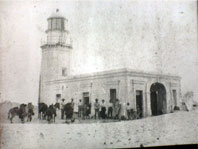Detailed Information
 In 1533, Hernán Cortés sailed to these lands after first being inspired by Garci Ordoñez de Montalvo’s novel "Esplandian,” in which he gave the name “California” to an imaginary country. Shortly after, Spanish merchant interests established a trade route from Luzon in the Philippines to Acapulco transporting oriental silks and spices, along with Mexican gold and silver, frequenting the tip of Baja along their journey. With all of these riches aboard their ships, pirates abounded. In 1587, Thomas Cavendish, one of the more infamous, sacked the "invincible" Spanish galleon Santa Ana off cape San Lucas. When news of this event reached the rest of Europe, a number of "Dutch Hens" entered the pirate trade against the Spanish as well. Joris van Spilbergen was the most famous of the group, sailing up and down the Pacific coastline at will, then mooring his ships and resting his men in the bays and inlets of Los Cabos and La Paz when the mood struck.
In 1533, Hernán Cortés sailed to these lands after first being inspired by Garci Ordoñez de Montalvo’s novel "Esplandian,” in which he gave the name “California” to an imaginary country. Shortly after, Spanish merchant interests established a trade route from Luzon in the Philippines to Acapulco transporting oriental silks and spices, along with Mexican gold and silver, frequenting the tip of Baja along their journey. With all of these riches aboard their ships, pirates abounded. In 1587, Thomas Cavendish, one of the more infamous, sacked the "invincible" Spanish galleon Santa Ana off cape San Lucas. When news of this event reached the rest of Europe, a number of "Dutch Hens" entered the pirate trade against the Spanish as well. Joris van Spilbergen was the most famous of the group, sailing up and down the Pacific coastline at will, then mooring his ships and resting his men in the bays and inlets of Los Cabos and La Paz when the mood struck.
To quell the looting, the Spanish Crown directed the Jesuits to go to California and convert the Indians and colonize the peninsula to keep the Dutch and the English at bay. The Jesuits took to the task and in 1697, after founding the first mission in Loreto, they began spreading the gospel north and south, all the way to Land’s End.
Centuries later, just after World War II, a group of Southern Californians learned they could fly to La Paz, then travel by rough, unpaved roads to the tip of Baja. The attraction was, not only did the Sea of Cortés teem with big game fish, the area was protected from a rash of “turistas” by its rough terrain, and was blessed with weather that was dry and warm 350 days of the year. Alas, the seclusion for this select few lasted little more than two decades. Finally, with better roads and then an airport, the boom began in earnest. Today, big game fishing, world-class golf, a variety of water activities, luxury hotel properties and spas, quaint hideaways and much more are enjoyed by thousands every year.
The waters along Los Cabos’ Pacific coast are characterized by ocean swells and upwellings of deep water, and because of the ocean’s distant weather patterns, heavy surf can arise for weeks at a time. The California Current keeps water temperatures lower than would be expected, typically between 50 and 75 degrees, gradually warming as the water moves south. Tropical storms called chubascos can bring torrential rains and heavy winds from mid-May to mid-November, peaking in August and September.
Plants in the Cape region of Los Cabos consist of cacti, yuccas, and various shrubs and, at low elevations, trees like palo blanco and palo verde. Just south, many familiar desert plants like ocotillo, ironwood, creosote bush, mesquite, agave, and various cacti, including the infamous jumping cholla can be found. While this is a desert environment, there are relatively well-watered areas that support distinctly non-desert vegetation, especially in the mountains where forests of pine, cedar, fir, aspen, and oak can be found. Encounters with coyotes and roadrunners are common here, as well as the not-so-common sightings of mule deer, mountain lion, bighorn sheep, antelope, and smaller animals such as fox, rabbit, bobcat, skunk, badger, raccoon, and a host of others.
Many reptile species also inhabit Los Cabos’ desert surroundings, including various species of rattlesnake and whiptail, king, and gopher snakes, and numerous iguanids, geckos, and lizards. And with an abundance of deserts, bays, mangrove lagoons, and forested peaks, a diverse mixture of bird life exists.
From an astronaut’s perspective, the Tip of Baja is one of the most striking geological features on earth, even though its mountains are not exceptionally tall. A series of mountain ranges runs south along Baja Sur to the vicinity just north of Los Cabos. Here are found two rugged mountain ranges, the Sierra de la Victoria and the Sierra de la Laguna. And just to the south of those, Los Cabos, a tale of two cities.



